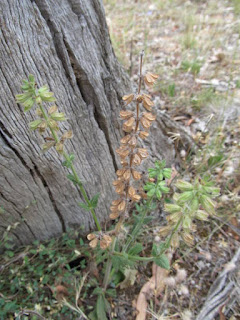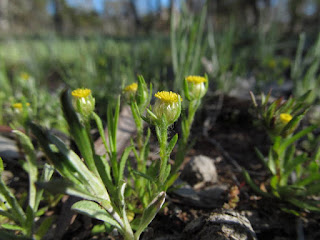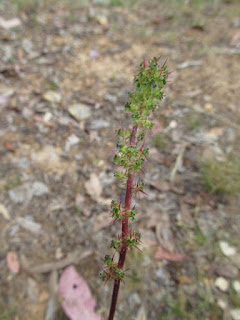Asterisks indicate introduced species. Last updated 23 October 2016.
Ferns
Ophioglossum lusitanicum
Widely distributed across the globe and apparently not even rare in Australia, but easily overlooked because it is tiny and green. We had been visiting Mt Majura reserve for six years before we saw it the first time.
Cheilanthes sieberi
These ferns are unusually drought-resistant, rolling up their leaves to conserve water as they dry out. There is at least one other very similar species in the genus.
Lilies / petaloid monocots
Stypandra glauca
Tricoryne elatior
Wurmbea dioica, Early Nancy
As the name implies there are separate female and male plants in this species.
Grasses
*Briza maxima
Legumes (Fabaceae)
Acacia decurrens
There are several similar species with large, bipinnate leaves.
Acacia genistifolia
The combination of white flowers and nasty spines makes it easy to recognise. Very localised.
Acacia genistifolia
The combination of white flowers and nasty spines makes it easy to recognise. Very localised.
Acacia parramattensis
There are several similar species with large, bipinnate leaves.
Cullen microcephalum
Daviesia genistifolia
These are the characteristic fruits, not the flowers.
Hovea heterophylla
*Trifolium angustifolium
Heath family (Ericaceae)
Astroloma humifusum
Melichrus urceolatus
Flowers early in the season.
Styphelia triflora
Only scattered plants here and there.
Broomrape family (Orobanchaceae)
*Orobanche minor
This species does not photosynthesise and is fully parasitic on the roots of other plants.
*Parentucellia latifolia
As a hemiparasite this species still does photosynthesis but taps the roots of other plants for water and nutrients.
Mint family (Lamiaceae)
*Marrubium vulgare
*Salvia verbenacea
Daisy family (Asteraceae)
Cassinia longifolia
Cassinia quinquefaria
Flowers very late in the season. This photo was actually taken on Mount Ainslie, but the species is quite common on Mount Majura.
Chrysocephalum apiculatum
Chrysocephalum semipapposum
Forms massive stands in many places.
Cotula australis
Widespread and common native, somewhat weedy. The flower-heads are tiny, the plants are usually only noticeable if there are many and they are fruiting.

Craspedia variabilis, billy buttons
Not very frequent, mostly along depressions where it is a bit moister. Larger and paler yellow than the Leptorhynchos, and it has a compound head.
Cymbonotus
There are two very similar species that can only be distinguished by their fruits.
*Dittrichia graveolens
Euchiton sphaericus
Although somewhat weedy-looking this cudweed is actually native. The flower-head is compound and seems to be very attractive to ants.

*Hypochaeris glabra
One of the most common weeds in Canberra, found nearly everywhere. Very characteristic in fruit: The inner fruits in each head have a beak between the seed and the pappus, the outer ones don't.
Isoetopsis graminifolia
Tiny, ephemeral, and obviously easily overlooked as it appears to be a very small grass at first sight.

Leptorhynchos squamatus, scaly buttons
Smaller and slightly more orange than the Craspedia, and it has a simple head of flowers.
Leucochrysum albicans var. tricolor, hoary sunray
This variety is considered threatened, but in the Canberra area it is still doing very well for itself. After good winter rains it covers large parts of Mount Majura and Mount Ainslie in white flower heads.
*Onopordum acanthium
Senecio quadridentatus
*Tolpis umbellata
A very small introduced weed, sometimes hard to spot between the other plants.
Triptilodiscus pygmaeus
A tiny ephemeral plant that does not come up every spring. I saw it on Mount Majura in 2010/11 and then not again until 2013/14.
Vittadinia muelleri
There are two other, quite similar species of this genus in the area but one is significantly larger and the other is woolly-hairy.
Xerochrysum viscosum, sticky everlasting
A close relative of the well-known golden everlasting X. bracteatum. Forms large stands in some places.
Other dicots
Acaena ovina, Rosaceae
The spiny fruit have a tendency to get stuck on socks and shoes.
Amyema miquelii, Loranthaceae
A mistletoe and as such a hemiparasitic epiphyte.
Brachychiton populneus, Sterculiaceae
Small tree producing large, blackish, leathery capsules. Quite frequent.
*Centaurium tenuiflorum, Gentianaceae
*Cicendia quadrangularis, Gentianaceae
Very tiny, thus easily overlooked. There is also an otherwise similar species with a round calyx in Australia.
Clematis microphylla var. leptophylla, Ranunculaceae
A climber. Rather rare and scattered in the area. This species has separate female and male plants.
Crassula sieberiana, Crassulaceae
In large carpets but small and between other plants. Often reddish.
Cryptandra amara, Rhamnaceae
Dwarf shrub occurring here and there in patches. Flowers very early in spring and has an amazingly sweet and intense floral scent. Although it looks like a heath it betrays its true taxonomic affiliation by the thorny branch apices.
Drosera peltata, Droseraceae
A tiny carnivorous plant that catches and digests small insects with its glandular hairs.
*Echium plantagineum, Pattersons Curse, Boraginaceae
Einadia nutans, Chenopodiaceae
Eucalyptus blakelyi, Myrtaceae
There are of course a few other eucalyptus species in the reserve, but I am not very good at those...
Exocarpos cupressiformis, Santalaceae
Another hemiparasite, the largest in the area. The flowers are ridiculously tiny.
Geranium solanderi, Geraniaceae
Goodenia hederacea, Goodeniaceae
A creeping plant with tough, dark leaves.
Goodenia pinnatifida, Goodeniaceae
Differs from the previous species in its upright growth and dissected leaves.
*Hirschfeldia incana
*Hypericum perforatum, St Johns Wort, Hypericaceae
The leaves are softer than in the previous species and have dark oil glands that are clearly visible when holding the leaf against the light
The leaves are softer than in the previous species and have dark oil glands that are clearly visible when holding the leaf against the light
*Linaria arvensis, Plantaginaceae.
The leaves are glaucous.
*Linaria pelisseriana, Plantaginaceae
*Myosotis discolor, Boraginaceae
Australia also has native species of the genus, but I haven't seen any on Mt Majura so far.
*Petrorhagia dubia, Caryophyllaceae
There is a second species of the genus in Australia, but its bract apices are blunt as opposed to having the small pointy tips of this species.

Solanum linearifolium, Solanaceae
Stackhousia monogyna, creamy candles, Celastraceae
Wahlenbergia, bluebell, Campanulaceae
There are several species, and I find them hard to distinguish.







































































No comments:
Post a Comment